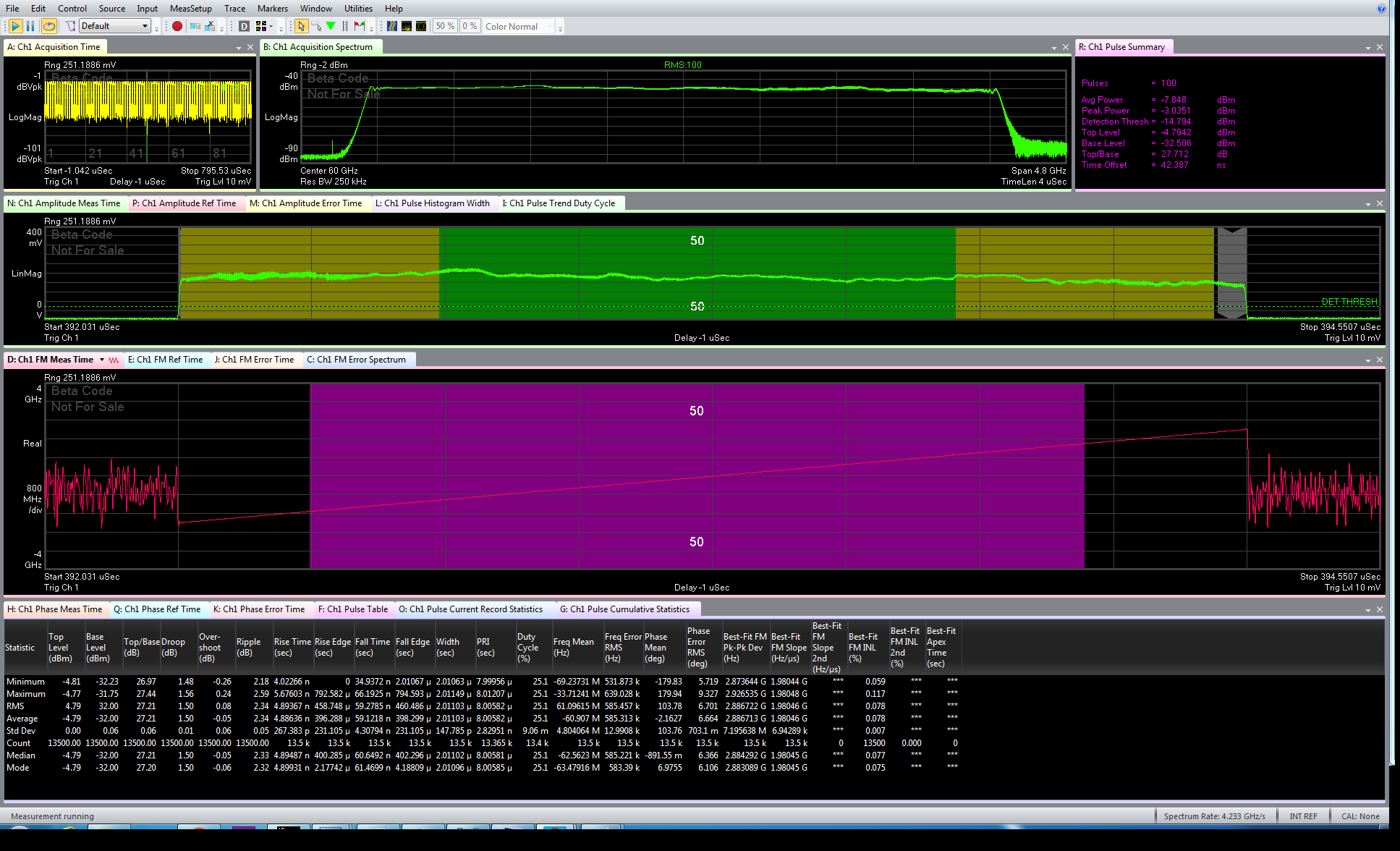keysight M8195A Broadband Pulse Radar Test Solution
The Wideband Pulse Radar Test Solution combines commercial off-the-shelf COTS modular hardware and software from Keysight Technologies, KJ Microwave, and Virginia Diodes to provide a flexible, multi-channel test bench for radar waveform generation and analysis.
Segmented memory acquisition in the digitiser uses a circular acquisition buffer with a minimum inter-segment dead time of 300 ns. This allows, for example, the capture of up to 64 million repetitive radar signals at relatively large repetition intervals. Real-time digital down-conversion DDC with frequency and phase response equalisation options combined with variable length segmented memory acquisition enables segmented capture where the length of each segment is optimised to capture radar pulses using real-time IF amplitude triggers and achieve the smallest dead time capture possible. Time stamps with down to femtosecond resolution let you know the exact time between each captured radar pulse. The test setup allows external cables, attenuators, or amplifiers to be de-embedded in front of the digitiser using the patented FPGA-based interleaved ADC amplitude and phase response equaliser.
The ADP7104 digitiser has excellent frequency response and phase response, which is critical for wideband radar signal capture. Patented group delay measurements are combined with patented digital equalisation [1][2] to create a calibrated baseband receiver with known amplitude and phase response in the DC -10 GHz band with an input signal range of -32 dBm to +22 dBm.
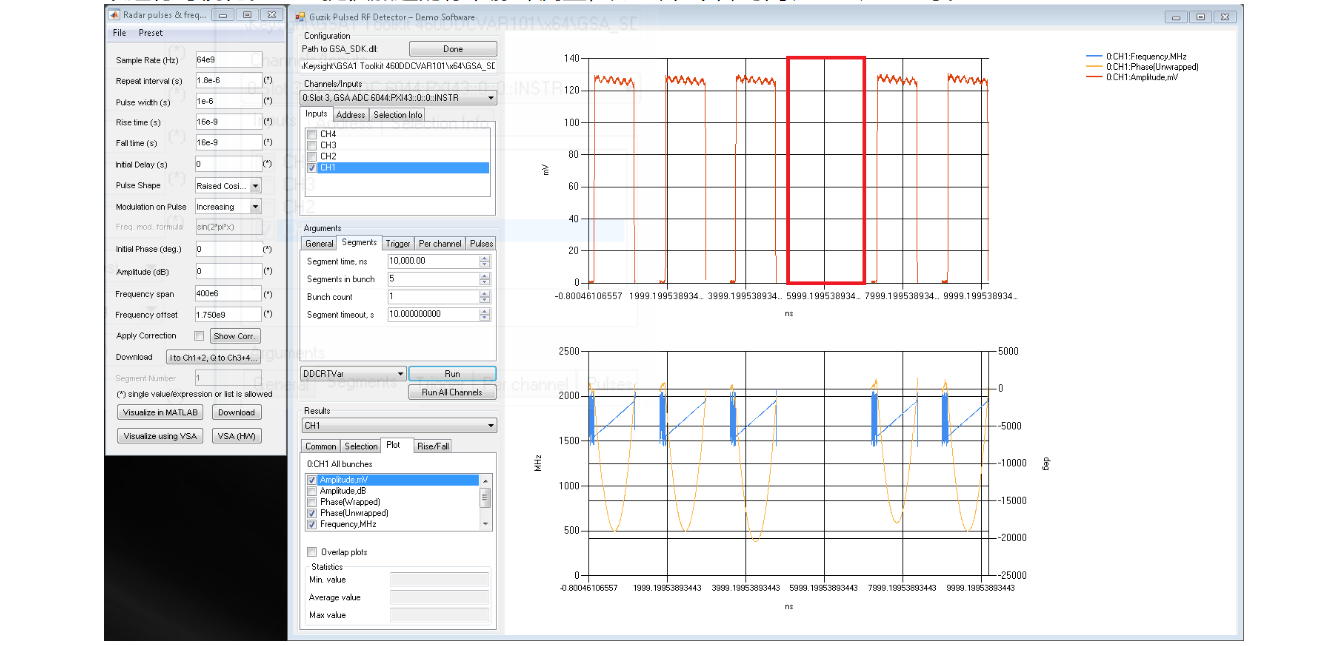
US Patent 7,408,495 Digital equalisation of multiple interleaved analogue-to-digital converters
U.S. Patent 9,933,467 Group delay measurement device and method
Software provides flexibility in generating and analysing radar waveforms having a variety of different attributes.
The pulsed RF detector software example program and its source code use the GSA_SDK and allow pulse parameters to be specified in order to capture only pulses of interest for visualisation.The SDK provides accelerated standard pulse measurements such as rise/fall times, PRF, PRI, etc. The SDK also allows for the use of the GSA_SDK as the source code for the pulsed RF detector.

In addition to flexible trace overlay support using the VSA 89600 software 89601B/BN-BHQ pulse analysis option, pulse signal modulation characteristics and impairment errors can be viewed in detail with multiple time-synchronised amplitude, phase and frequency (FM) trace results. All key pulse signal modulation performance metrics related to power, dropout, overshoot, ripple, time (rise/fall/width/PRI), frequency, phase, and FM modulation can be verified using the comprehensive Pulse Table tabular results metrics.
Use the Pulse Cumulative Statistics table, graphical histograms and trendline trace plots to quickly view the statistical variance performance data for each reported pulse metric, accumulated over single or multiple acquisitions. Powerful and flexible trace views such as spectrograms and cumulative histories provide greater insight into the dynamic and spurious performance of signals in both the time and frequency domains.
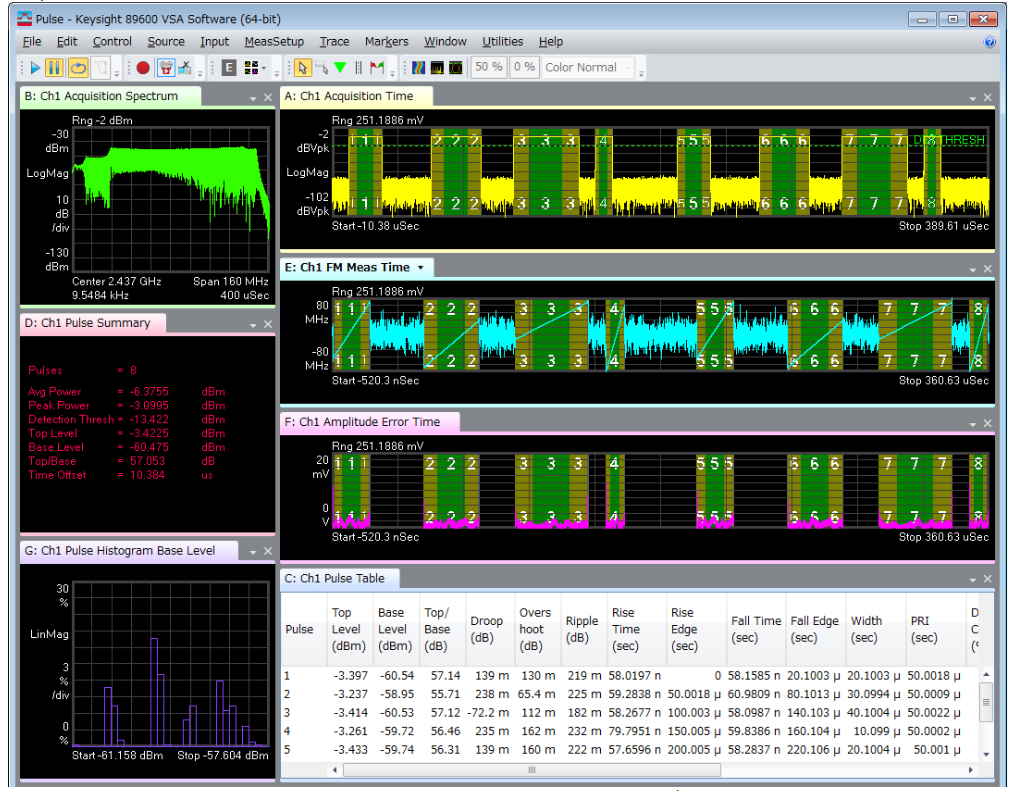
The YesTech Pulse Descriptor Word Collector Software (PS-X10-100) is a radar-focused analysis software package for measuring signals with frequency over time and creating PDWs as outputs.
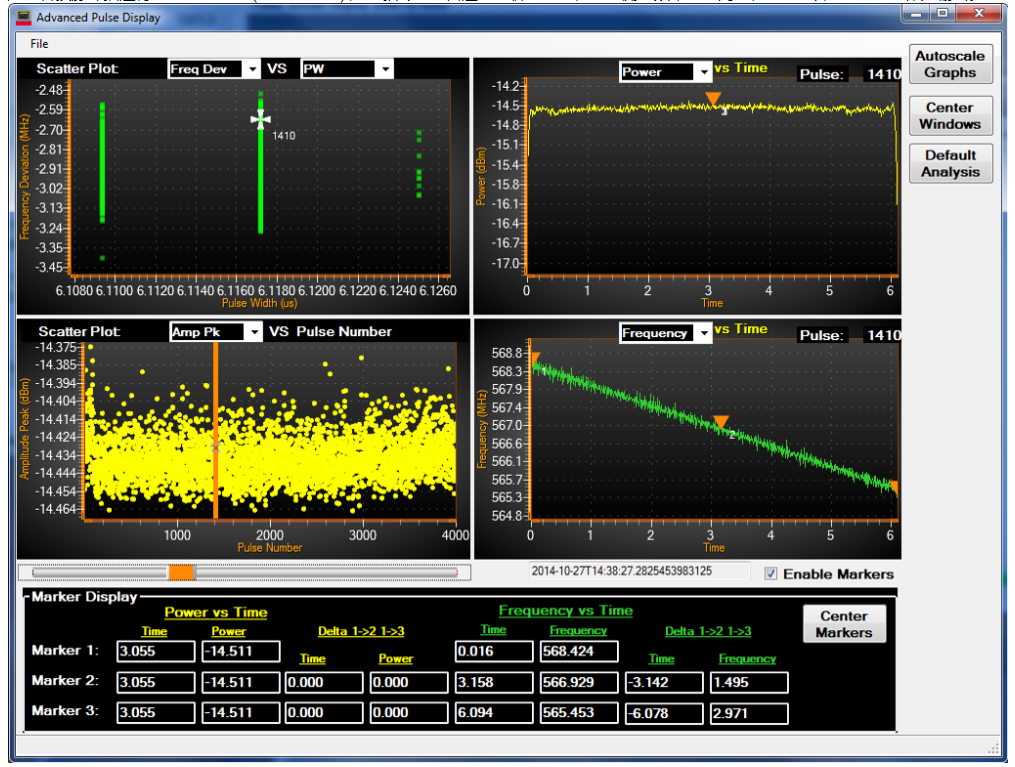
Modular hardware provides the flexibility to support baseband, IF, microwave and millimetre wave test planes.
The basic test equipment configuration supports frequencies up to 10 GHz for a wide range of IFs. The digitiser's direct RF sampling capability covers radar signals in the HF, VHF, UHF, L, S, C and some X-bands. Direct RF sampling reduces overall system complexity by eliminating multiple input analogue downconverter stages. 8-110 GHz X, Ku, Ka, mm, V and W band frequencies can be generated and analysed using our partners' upconverters and downconverters. KJ Microwave AXIe upconverters and downconverters cover 3.2 GHz - 19.2 GHz. Virginia Diodes compact upconverters and downconverters cover 22.5 GHz - 110 GHz.
This reference solution can be used as a standalone reference to help debug and verify hardware performance issues as they occur.
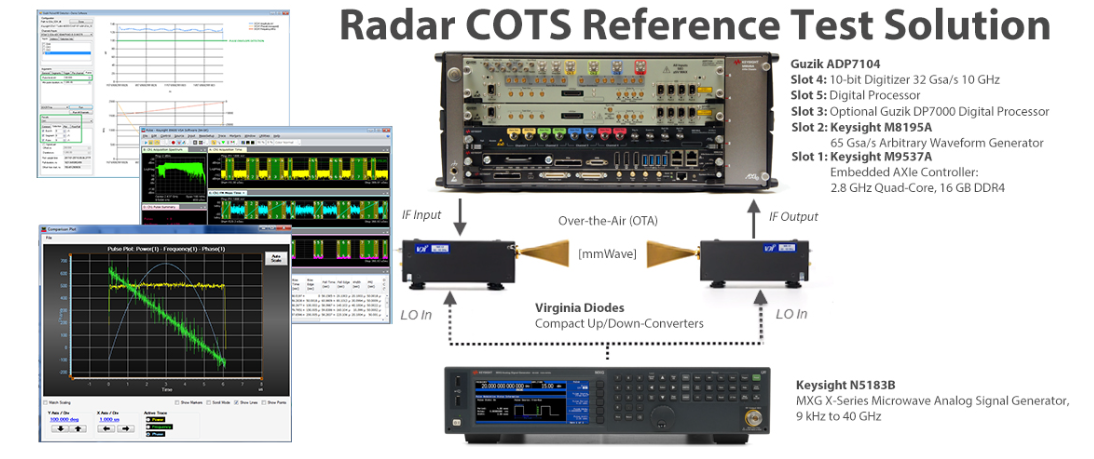
Measurement applications and software:
Keysight Signal Studio N7620B for Pulse Construction
Pulsed RF Detector Software Sample Program
Keysight 89600 VSA Software with 89601B/BN-BHQ Pulse Analysis Option
Isotek Pulse Descriptor Word Collector
WR-15 Waveguide Band Reference Setting.
WR15CCU 50-75 GHz Compact Converter Upconverter (CCU)
VDI15.0AMP-0055/0067-15-20 Amplifier band 55-67 GHz, gain ~17 dB
VDI15.0BPFE57.24-65.88 Bandpass Filter, Insertion Loss < 1 dB
WR-15 Waveguide, V-Band Attenuator
WR15CCD 50-75 GHz Compact Downconverter (CCD)
For simplicity, the following measurements in the millimetre-wave range were performed with the waveguide interface WR-15.
Using a waveguide antenna for over-the-air radiated emission (OTA) measurements may result in high attenuation. Each ADP7104 digitiser channel has an adjustable front end (-32 dBm to +22 dBm in 1 dB steps) to fine-tune the receiver for optimal SNR.
4GHz wide 2-microsecond LFM linear FM IF performance (with precorrection):
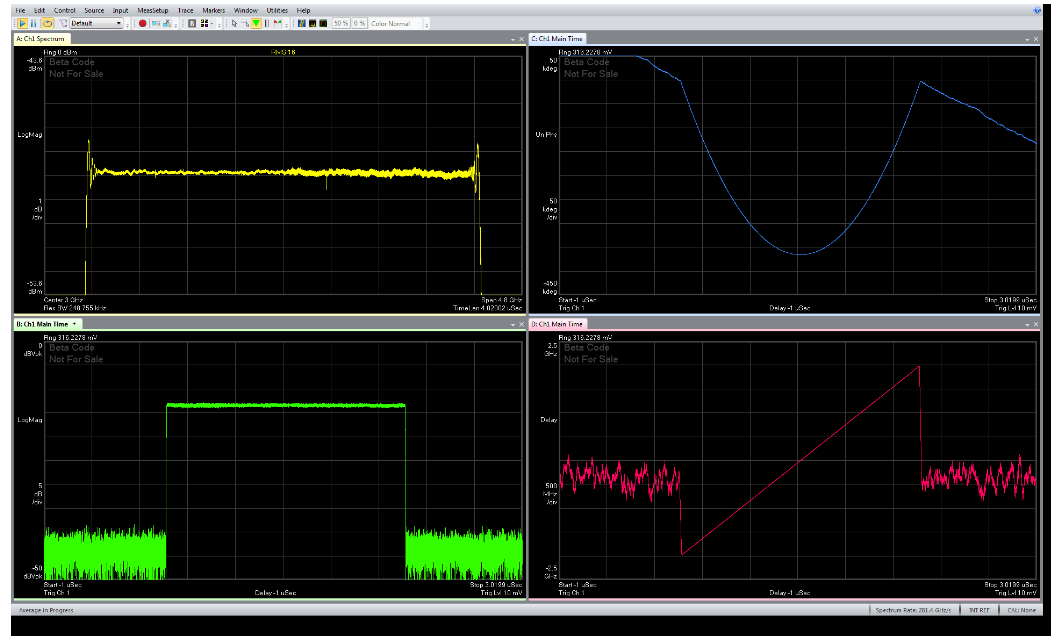
4GHz wide 2 microsecond LFM linear FM performance at millimetre wave 60 GHz centre frequency:
Statistical analysis of 4GHz wide 2 microsecond LFM linear FM millimetre wave using VSA 89600 software option BHQ:
Note: The example measurements provided in the application are representative and were taken under ideal conditions at an ambient temperature of +25°C without "pre-calibration". Results are not guaranteed specifications.
The Wideband Pulse Radar Test Solution combines commercial off-the-shelf COTS modular hardware and software from Keysight Technologies, KJ Microwave, and Virginia Diodes to provide a flexible, multi-channel test bench for radar waveform generation and analysis.
Segmented memory acquisition in the digitiser uses a circular acquisition buffer with a minimum inter-segment dead time of 300 ns. This allows, for example, the capture of up to 64 million repetitive radar signals at relatively large repetition intervals. Real-time digital down-conversion DDC with frequency and phase response equalisation options combined with variable length segmented memory acquisition enables segmented capture where the length of each segment is optimised to capture radar pulses using real-time IF amplitude triggers and achieve the smallest dead time capture possible. Time stamps with down to femtosecond resolution let you know the exact time between each captured radar pulse. The test setup allows external cables, attenuators, or amplifiers to be de-embedded in front of the digitiser using the patented FPGA-based interleaved ADC amplitude and phase response equaliser.
The ADP7104 digitiser has excellent frequency response and phase response, which is critical for wideband radar signal capture. Patented group delay measurements are combined with patented digital equalisation [1][2] to create a calibrated baseband receiver with known amplitude and phase response in the DC -10 GHz band with an input signal range of -32 dBm to +22 dBm.

US Patent 7,408,495 Digital equalisation of multiple interleaved analogue-to-digital converters
U.S. Patent 9,933,467 Group delay measurement device and method
Software provides flexibility in generating and analysing radar waveforms having a variety of different attributes.
The pulsed RF detector software example program and its source code use the GSA_SDK and allow pulse parameters to be specified in order to capture only pulses of interest for visualisation.The SDK provides accelerated standard pulse measurements such as rise/fall times, PRF, PRI, etc. The SDK also allows for the use of the GSA_SDK as the source code for the pulsed RF detector.

In addition to flexible trace overlay support using the VSA 89600 software 89601B/BN-BHQ pulse analysis option, pulse signal modulation characteristics and impairment errors can be viewed in detail with multiple time-synchronised amplitude, phase and frequency (FM) trace results. All key pulse signal modulation performance metrics related to power, dropout, overshoot, ripple, time (rise/fall/width/PRI), frequency, phase, and FM modulation can be verified using the comprehensive Pulse Table tabular results metrics.
Use the Pulse Cumulative Statistics table, graphical histograms and trendline trace plots to quickly view the statistical variance performance data for each reported pulse metric, accumulated over single or multiple acquisitions. Powerful and flexible trace views such as spectrograms and cumulative histories provide greater insight into the dynamic and spurious performance of signals in both the time and frequency domains.

The YesTech Pulse Descriptor Word Collector Software (PS-X10-100) is a radar-focused analysis software package for measuring signals with frequency over time and creating PDWs as outputs.

Modular hardware provides the flexibility to support baseband, IF, microwave and millimetre wave test planes.
The basic test equipment configuration supports frequencies up to 10 GHz for a wide range of IFs. The digitiser's direct RF sampling capability covers radar signals in the HF, VHF, UHF, L, S, C and some X-bands. Direct RF sampling reduces overall system complexity by eliminating multiple input analogue downconverter stages. 8-110 GHz X, Ku, Ka, mm, V and W band frequencies can be generated and analysed using our partners' upconverters and downconverters. KJ Microwave AXIe upconverters and downconverters cover 3.2 GHz - 19.2 GHz. Virginia Diodes compact upconverters and downconverters cover 22.5 GHz - 110 GHz.
This reference solution can be used as a standalone reference to help debug and verify hardware performance issues as they occur.

Measurement applications and software:
Keysight Signal Studio N7620B for Pulse Construction
Pulsed RF Detector Software Sample Program
Keysight 89600 VSA Software with 89601B/BN-BHQ Pulse Analysis Option
Isotek Pulse Descriptor Word Collector
WR-15 Waveguide Band Reference Setting.
WR15CCU 50-75 GHz Compact Converter Upconverter (CCU)
VDI15.0AMP-0055/0067-15-20 Amplifier band 55-67 GHz, gain ~17 dB
VDI15.0BPFE57.24-65.88 Bandpass Filter, Insertion Loss < 1 dB
WR-15 Waveguide, V-Band Attenuator
WR15CCD 50-75 GHz Compact Downconverter (CCD)
For simplicity, the following measurements in the millimetre-wave range were performed with the waveguide interface WR-15.
Using a waveguide antenna for over-the-air radiated emission (OTA) measurements may result in high attenuation. Each ADP7104 digitiser channel has an adjustable front end (-32 dBm to +22 dBm in 1 dB steps) to fine-tune the receiver for optimal SNR.
4GHz wide 2-microsecond LFM linear FM IF performance (with precorrection):

4GHz wide 2 microsecond LFM linear FM performance at millimetre wave 60 GHz centre frequency:
Statistical analysis of 4GHz wide 2 microsecond LFM linear FM millimetre wave using VSA 89600 software option BHQ:
Note: The example measurements provided in the application are representative and were taken under ideal conditions at an ambient temperature of +25°C without "pre-calibration". Results are not guaranteed specifications.








